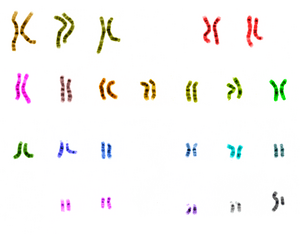Genome facts for kids

Imagine a complete instruction book for building and running an organism. That's basically what a genome is! It's all the hereditary information an organism has, stored in its DNA. For some tiny viruses, this information is in RNA instead. Your genome includes all your genes, which are like specific recipes, and other parts of DNA that don't make genes but still have important jobs. The word 'genome' was first used in 1920.
Every living thing has a genome. It's like a master plan that tells your body how to grow, how to work, and even what color your eyes will be.
Most living things, like humans, have two copies of their genome in each cell. This is called a diploid genome. You get one copy from your mother and one from your father. Some simple organisms, like bacteria, only have one copy, which is called a haploid genome.
The term 'genome' usually refers to all the DNA found in the main part of a cell, called the nucleus. This is the 'nuclear genome'. But some parts of a cell, like mitochondria (the cell's powerhouses) and chloroplasts (in plants, where food is made), also have their own small sets of DNA. These are called the mitochondrial genome or chloroplast genome.
How Big Are Genomes?
Genomes come in all different sizes! The size of a genome is measured by the number of base pairs it has. Base pairs are the building blocks of DNA. A larger number of base pairs means a bigger instruction book.
Here's a look at the genome sizes of different organisms:
| Organism | Genome size (base pairs) | Note |
|---|---|---|
| Virus, Bacteriophage MS2 | 3569 | First sequenced RNA-genome |
| Virus, SV40 | 5224 | |
| Virus, Phage Φ-X174 | 5386 | First sequenced DNA-genome |
| Virus, Phage λ | 5×104 | |
| Bacterium, Candidatus Carsonella ruddii | 1.6×105 | Smallest non-viral genome (Feb 2007) |
| Bacterium, Escherichia coli | 4×106 | A very well-studied bacterium |
| Bacterium, Solibactoer usitatus | 1×107 | Largest known bacterial genome |
| Protist, Amoeba dubia | 6.7×1011 | Largest known genome, but some scientists question this |
| Plant, Arabidopsis thaliana | 1.57×108 | First plant genome sequenced (Dec 2000) |
| Plant, Genlisea margaretae | 6.34×107 | Smallest recorded flowering plant genome (2006) |
| Plant, Fritillaria assyrica | 1.3×1011 | |
| Plant, Populus trichocarpa | 4.8×108 | First tree genome (Sept 2006) |
| Yeast, Saccharomyces cerevisiae | 2×107 | |
| Fungus, Aspergillus nidulans | 3×107 | |
| Nematode, Caenorhabditis elegans | 9.8×107 | First multicellular animal genome (Dec 1998) |
| Insect, Drosophila melanogaster (fruit fly) | 1.3×108 | |
| Insect, Bombyx mori (silk moth) | 5.30×108 | |
| Insect, Apis mellifera (honey bee) | 1.77×109 | |
| Fish, Tetraodon nigroviridis (puffer fish) | 3.85×108 | Smallest vertebrate genome known |
| Mammal, Homo sapiens | 3×109 | |
| Fish, Protopterus aethiopicus (marbled lungfish) | 1.3×1011 | Largest vertebrate genome known |
Note: The DNA from a single human cell is very long, about 1.8 meters (almost 6 feet) if you stretched it out! But it's also incredibly thin, only about 2.4 nanometers wide.
Related Topics
- Gene
- Sequence analysis
- ENCODE: a big project that studied the human genome in detail
Images for kids
See also
 In Spanish: Genoma para niños
In Spanish: Genoma para niños


